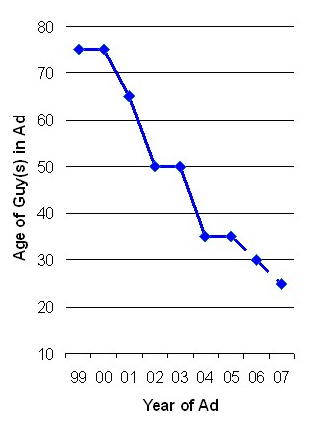- Vol. 3, No. 5: May 2004 – CONTENTS
Upfront
Pushing the Envelope is Bad for DTC
Have you noticed that the men in the Direct-to-Consumer (DTC) ads for Cialis, Levitra, and Viagra are getting younger and younger?
 The Viagra ads began by featuring Bob Dole, who was 76 at the time (1999). Levitra started out with Mike Ditka (age 65), while Viagra shifted to Joe, who is maybe 45 or 50. The Cialis guys in the bathtub and convertible also look about 45 to 50. But the new Levitra guy looks thirty-something. His wife-or is it just his “gal?”-is stunning and looks even younger!
The Viagra ads began by featuring Bob Dole, who was 76 at the time (1999). Levitra started out with Mike Ditka (age 65), while Viagra shifted to Joe, who is maybe 45 or 50. The Cialis guys in the bathtub and convertible also look about 45 to 50. But the new Levitra guy looks thirty-something. His wife-or is it just his “gal?”-is stunning and looks even younger!
I plotted this age trend (see chart) and predict that by 2006, the ads will show men and women in their twenties-hardly the demographic likely to be suffering from erectile dysfunction (ED).
There’s a one-upmanship game going on here, where one product takes it a step further than the other to push the envelope. Cialis began using couples in benign pseudo-sexual situations. You understood something was going to happen, but off-camera as it were. Viagra did this first, but in a much more subtle way without a lot of “touchy-feely” interactions.
Then, Levitra dumped Ditka and brought in a sexy brunette with poses straight from the Victoria’s Secret catalog (“my guy” ad). I am not sure how much more explicit the ads can become. The Levitra ad already talks about “improve[ing] erection quality time and time again.”
Prurient interest aside, none of the ads provides much education about the indicated condition or who might suffer from it and benefit from seeking medical attention.
If the trend continues, lawmakers-some of whom already are gunning for DTC-are sure to take notice. In my opinion, ED product marketers should declare a moratorium on this ad “shoot out” before it is too late. It’s not doing anything to prove the argument that DTC is educational and it certainly is not sending the right message to the FDA, which just recently issued new guidances applauding the benefits of DTC advertising.
See Survey Results: Are ED Ads Too Sexually Explicit?

![]()
John Mack, Publisher and Editor
editor@pharmamarketingnews.com
Article Summaries
FEATURE ARTICLE
Searching for Answers on Search Engine Marketing?
By Mitch Bernstein
Yahoo’s record earnings and Google’s IPO announcement are hot financial stories, but they also herald an important trend that is changing the way marketers think about the interactive channel. Search Engine Marketing, also known as SEM or Search, is one of the fastest-growing e-marketing strategies today.
Advertisers both large and small are seeing impressive results from Search. How can pharmaceutical marketers navigate this medium to take advantage of what is rapidly becoming the most efficient way to drive action on their Web sites?
The author covers SEM techniques such as Paid Search, Paid Inclusion, and Natural Search, and suggests that to stay ahead, companies must develop sophisticated content strategies to win the war of visibility.
More…
Order the REPRINT now for $6.95 (PDF file delivered to you by email):
CASE STUDY
Expanding New Patient Starts Through Broader Physician Sample Coverage
Physicians have shown very high interest in ordering samples online, and now, through partnerships with major physician portals, brands can selectively target physicians and build a regular online relationship around sample ordering.
Access the full-text version of this case study at: http://ec2-54-175-84-28.compute-1.amazonaws.com/pharma-mkting.com/resources/cases/CS-M134c1.htm
CONFERENCE HIGHLIGHT
European Compliance Not Only Possible, But Leading Edge
By Jack Barrette
As US pharmaceutical companies search for best practices to battle patient drop-off, their European counterparts have overcome Byzantine regulations and reduced margins to implement strikingly effective compliance programs.
At the recent CBI Patient Compliance and Persistence conference in Philadelphia, Len Starnes, Head of European eBusiness for Schering AG, demonstrated the challenges – and successes – of conducting Direct To Patient support in the European Union (EU). Starnes is charged by Schering with spreading awareness about compliance programs throughout the company, especially the use of the internet and mobile channels to support pan-European efforts in all 21 EU member states.
More…
Order the REPRINT now for $6.95 (PDF file delivered to you by email):
CONFERENCE HIGHLIGHT
The Revitalized Brand: Creating a New Brand Image from an Old Product
By Neville Dickson
This article summarizes a presentation made by Lynne Brookes, Vice President, US Marketing, Cephalon Inc. at EyeforPharma’s “Successful Product Branding in Pharma” conference in London, UK on 23 March 2004.
Brookes has built her considerable reputation on turning around marketing blunders. Cephalon has acquired other people’s brands that hadn’t done well in the marketplace, yet had unique features that could be presented in a more favorable light. Without the luxury of a huge marketing budget, and not a lot of time either, Brookes has first to undo the harm already done to the ailing brand. “It’s not rocket science,” she claims. “You need to be clear about what the drug does, and the benefit(s) the drug provides.”
We all know that. Yet strangely enough, many pharma marketing campaigns go to great expense and miss these points completely.
More…
Order the REPRINT now for $6.95 (PDF file delivered to you by email):
CONFERENCE HIGHLIGHT
Branding as a Management Tool in Pharma
By Neville Dickson
In a world crowded with many similar competing consumer goods, the most successful companies have been those who control the marketing, sales AND distribution systems. Government intervention, complex reimbursement systems and numerous intermediaries, however, handicap the pharma industry, which is a long way behind Fast Moving Consumer Goods (FMCG) in terms of product branding.
The views of Jesper Kunde, one of Europe’s fastest-rising marketing gurus and author of the book Corporate Religion, are reviewed in this article, which summarizes Kunde’s presentation at EyeforPharma’s “Successful Product Branding in Pharma” conference in London, UK in March 2004.
More…
Order the REPRINT now for $6.95 (PDF file delivered to you by email):
GUEST ARTICLE
Direct-To-Consumer Advertising: Developing Evidence-Based Policy To Improve Retention And Comprehension
By David L. Riggs, Stacy M. Holdsworth, and David R. McAvoy
Pharmaceutical advertising was historically directed toward health care professionals and mainly communicated through medical journals. The arrival of direct-to-consumer advertising has sparked both praise and criticism. Although current Food and Drug Administration requirements for drug promotion were written from a health care professional perspective, the same regulations have been applied to advertising directed at consumers. This has led to questions regarding the appropriate method for communicating detailed medical information. Rigorous research is needed to evaluate and determine the most effective format for communicating benefit and risk information to consumers. New standards for drug advertising to consumers should be grounded in data derived from this type of research.
More…
![]() Read the full text of this article (PDF format).
Read the full text of this article (PDF format).
SURVEY
Impact of the PhRMA Code on Pharmaceutical Marketing and Sales
The PhRMA Code on Interactions with Healthcare Professionals, which became effective in July 2002, affirms that a sales reps primary function is to educate and inform doctors. In pursuit of this function, certain activities are supposed to be forbidden. However, there may be some differences among pharmaceutical companies regarding the interpretation of the Code and how it is applied in practice.
Pharma Marketing News hosted a survey of its subscribers and visitors to the Pharma Marketing Network Web site about this issue. We received 31 responses from people working within branded pharmaceutical companies as well as people working on the vendor side (medical communications companies, marketing agencies, and consultants).
More…
![]() Read the full text of this article (PDF format).
Read the full text of this article (PDF format).



![6 Digital Tools at the Center of Healthcare Digitalization [INFOGRAPHIC]](http://ec2-54-175-84-28.compute-1.amazonaws.com/pharma-mkting.com/wp-content/uploads/2021/04/6DigitalTools_600px-218x150.jpg)




![6 Digital Tools at the Center of Healthcare Digitalization [INFOGRAPHIC]](http://ec2-54-175-84-28.compute-1.amazonaws.com/pharma-mkting.com/wp-content/uploads/2021/04/6DigitalTools_600px-100x70.jpg)




